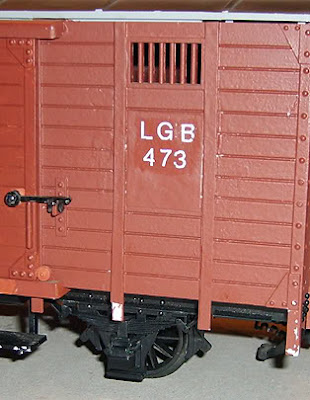 The Dubonnet freightcar started its life as an altered LGB freightcar I bought second hand.
The Dubonnet freightcar started its life as an altered LGB freightcar I bought second hand. It was altered a bit by a former owner by placing a window in both sides. This gave it somewhat an appearance of a luggagecar and I liked the look of it.
 |
| From a distance the damages are not directly noticeable |
From a distance it was not directly noticeable but the car had some mayor damages. There were multiple deep scratches on the surface as if the van was once attacked with a chisel or something. The heaviest damages were disguised with plastic sheets glued over. Some other scratches were filled up with putty causing a bit of a lumpy look.
 |
| Sheets covering damages |
 |
| Scratches, filler and glue residues |
I carefully removed the plastic sheets and the filler using a Dremel tool. It was possible to carve in new lines for the planking on the sides.
The brown paint was not original LGB but applied later on the model. The model was original white plastic. I decided to strip of all paint using MrMuscle ovencleaner in a plastic bag.
 |
| Stripping of paint |
After cleaning the model the white plastic was giving away this was originally a LGB 4031 series freightcar. The white perfectly showed all the spots that need tender love and care.
Using Tamiya putty I tried to recover all the damaged spots as neat and clean as I could. On some places I needed to carve in planking lines. This was not always as straight and clean as I desired but than again the planking on sidings of old heavy used freightcars seldom do.
Also new frames for the windows and door at the head side were made from styrene strips
When all the work was done the car was sprayed light brown and weathered. The result was a very nice freight / luggage van.
I came up with the idea to add a commercial sign / advertising on the sides with was a common thing on some secondary railways and tramways.
A suitable old French commercial Dubonnet sign was found and printed on decal paper from Testors.
These work just like the waterslide decals that you find in plastic kits. Because they are very thin it will look like as if the sign was painted on the surface.
There are 2 things that need attention when printing decals on an inkjet printer:
1. spray a varnish or clear coat over the decals after printing. This will protect the print against the water and prevent the colors to wash away.
2. bare in mind that 'white' is not a color that a printer prints. This means the transparent decal will stay transparent where it actually need to be white. Therefor I needed to paint the surface where the decal must be placed white. If I had not done this the letters "Dubonnet" would be as brown as the planking.
It is actually better always paint the surface white because all colors of the decal will come out much better than on a colored surface.
I needed 2 signs but I printed 4 so I had some reserve if I screw a decal up. However the decal paper works very fine and applying them was very easy, especially using setting solutions Micro Set and Micro Sol.
I also used white numbers and letters for some lettering, like the car number. These decals came from 1:35 scale Russian Army military kits.
 |
| Testors decalpaper and Micro Set and Micro Sol |
 |
| Painting surface white |
 |
| The end result |
 |
| Du bon, du beau, du bonnet |
 |
| On the old layout |
You can find this car also on the Garten Bahn Database
-o-













No comments:
Post a Comment